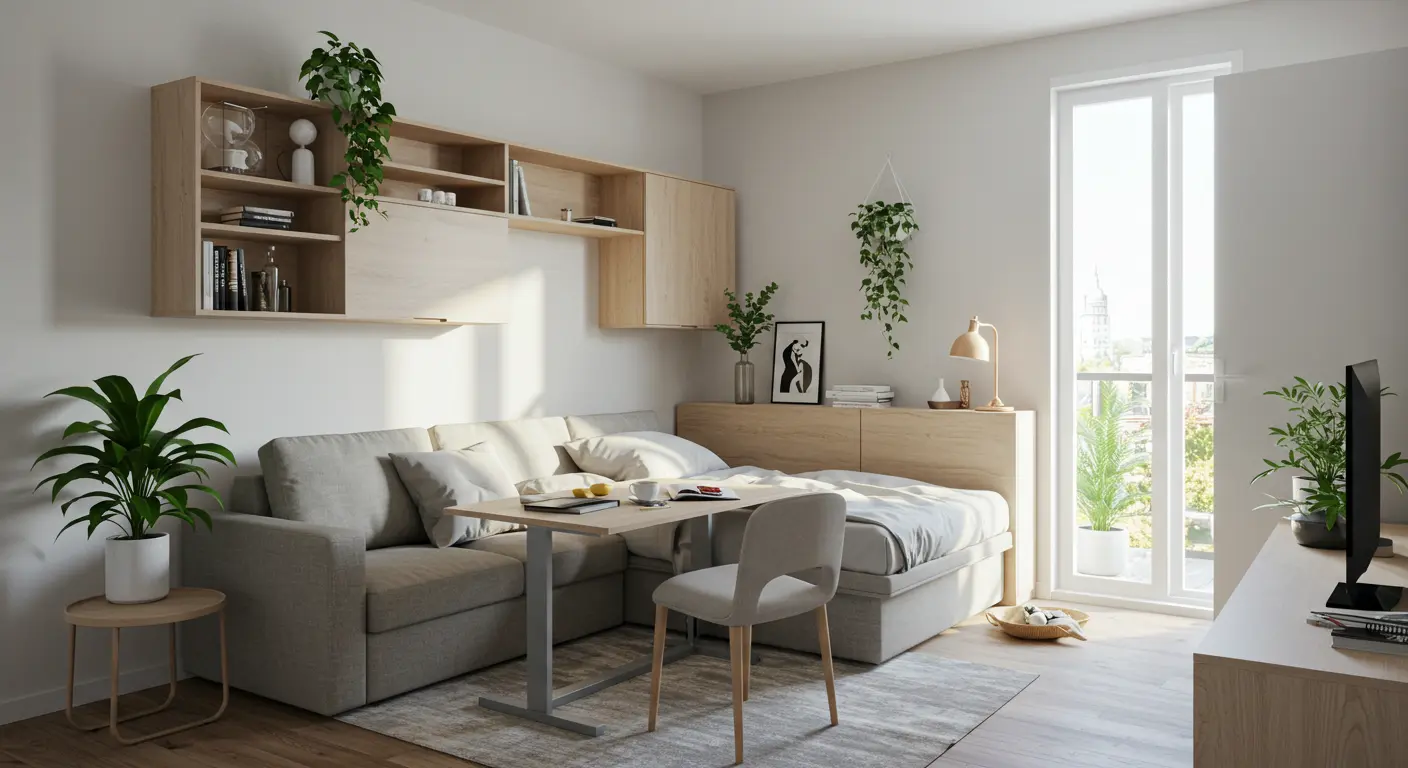
Did you know that living in a small apartment can be synonymous with freedom and style? With minimalism, every inch transforms into well-being, organization, and beauty. Instead of fighting against the lack of space, how about using it to your advantage?
In this article, you’ll discover how to create a minimalist environment in your small apartment, valuing functionality without sacrificing coziness. Get ready to transform your home with simple, practical solutions full of personality.
If you’re just getting started and want to transform every inch of your home with lightness and style, we also recommend checking out these 10 practical minimalist interior design tips for small spaces.
Understanding the Minimalist Style
Before applying minimalism to your space, it’s essential to understand its essence. Much more than an aesthetic trend, minimalism is a lifestyle that values the essential and eliminates excess — and that’s exactly why it works so well in small apartments.
When dealing with compact spaces, every choice matters: every piece of furniture, every object, every color. Minimalism helps prioritize what truly makes sense, creating lighter, more organized, and welcoming environments.
The basic principles of minimalism
To apply the style authentically, it’s important to keep three fundamental pillars in mind:
- Functionality: Everything in the environment must have a clear function. Avoid purely decorative items that take up space without purpose.
- Simplicity: Straight lines, clean shapes, and a neutral color palette help create a calm and timeless aesthetic.
- Purpose: Each element should reflect an intention. Less quantity, more meaning.
Living minimally is also an invitation to self-discovery: you choose more consciously what stays in your home — and, consequently, in your life.
Clean doesn’t mean cold
A common mistake is associating minimalist environments with coldness or impersonality. But the truth is that it’s entirely possible — and desirable — to create a cozy minimalist space.
The key lies in materials and textures: natural wood, fabrics like linen and cotton, indirect lighting, and plants are excellent resources to warm up the look without compromising lightness.
Furthermore, including objects with emotional value, like a meaningful painting or a handcrafted piece, brings identity to the environment and dispels the feeling of a “catalog home.”
To dive deeper into this topic and explore combinations that balance aesthetics and well-being, be sure to check out our article on textures and materials in minimalist design that bring visual comfort.
Assessing the Space You Have
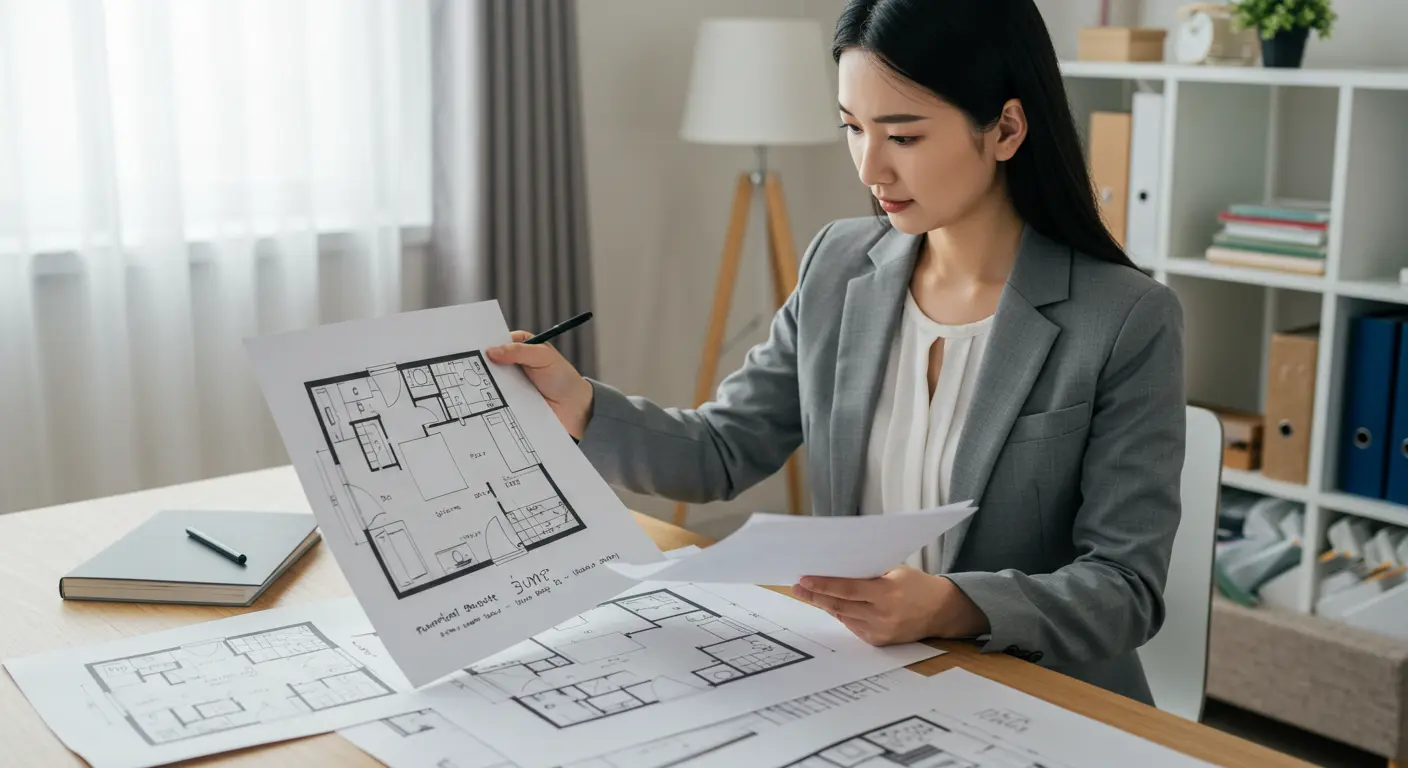
Before transforming your apartment into a minimalist retreat, it’s essential to understand what you have on hand. Assessing every corner of your space is the first step to planning environments that are beautiful, functional, and personalized all at once.
Map out your apartment
Take a moment to observe all the rooms with a fresh perspective. Notice clutter hotspots, the furniture you actually use, and spaces that could be better utilized. A simple pen and paper are enough to create a sketch of the current layout, with notes for improvements.
Some guiding questions:
- Which pieces of furniture take up a lot of space but have little utility?
- Where is there visual clutter or accumulated objects?
- Which areas could be more functional?
This diagnosis is powerful. It will help you understand what’s working — and what’s just taking up space.
Define the main functions of each room
In minimalism, each room needs clarity of function. This prevents the accumulation of purposeless objects and simplifies organization.
For example:
- Is your living room just for receiving guests, or does it also serve as a workspace?
- Can the bedroom have a reading nook, or should it be exclusively for rest?
- Does the kitchen need to house many appliances, or is the basic setup sufficient?
With defined functions, it becomes much easier to choose the ideal furniture and avoid unnecessary excess.
Practical tip: start one room at a time
Trying to change the entire apartment at once can be tiring — and demotivating. Therefore, the golden rule is: start small, but start now.
Choose one room to apply the minimalist concept, like the bedroom or living room, and put it into practice:
- Take everything out of the space
- Evaluate item by item: what is useful, what makes you feel good, and what can go
- Reorganize with more free space and functionality
Over time, you’ll notice how minimalism fits naturally into your routine, and you’ll want to expand it to the rest of the house.
Choosing Smart and Multifunctional Furniture
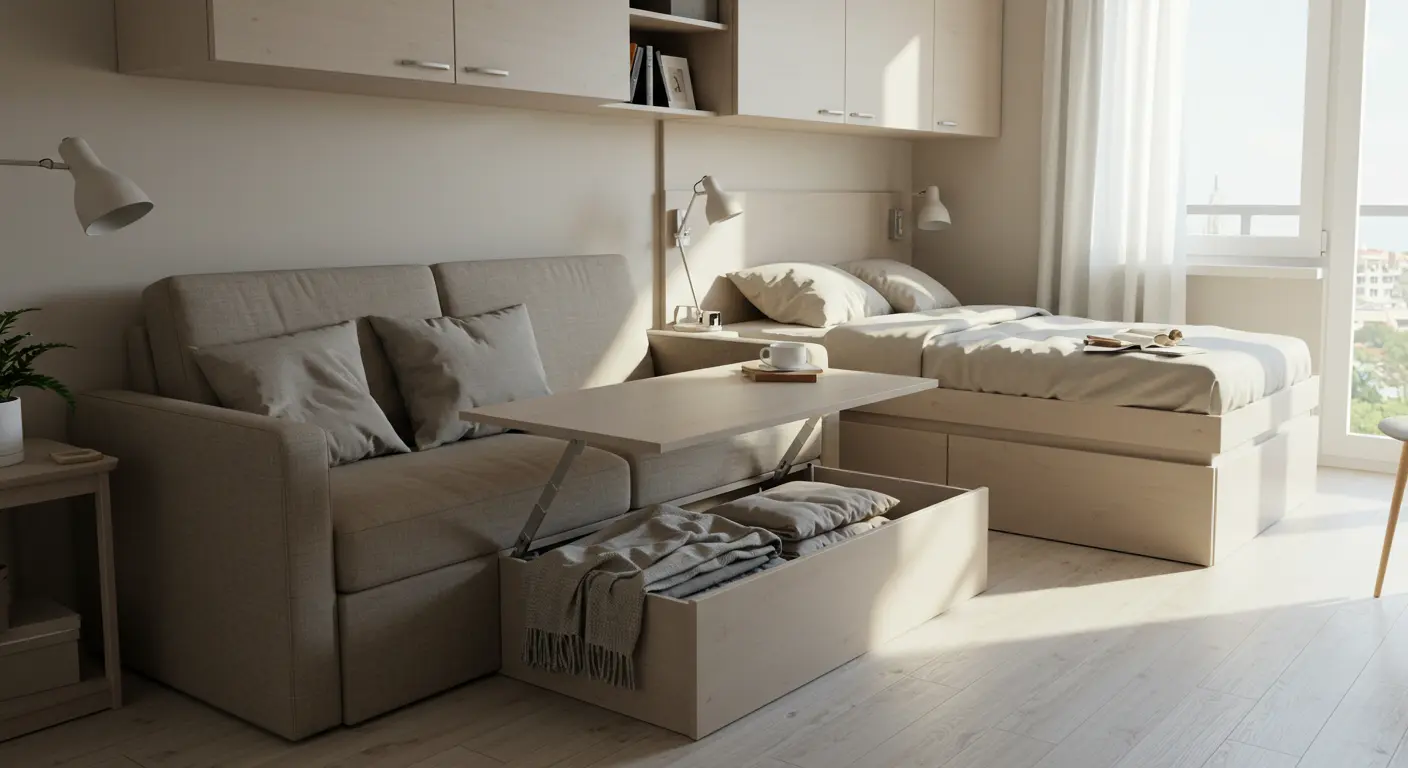
In small apartments, every choice needs to be strategic — especially when it comes to furniture. A well-thought-out piece can transform an entire room, save space, and offer practical solutions for daily life. In the minimalist style, less is more, and each piece should add beauty and functionality to the environment.
Dual-function furniture: smart utilization
Opting for multifunctional furniture is one of the wisest decisions in a minimalist project for compact spaces. Besides optimizing the environment, they prevent the accumulation of unnecessary pieces.
Here are some examples that work very well:
- Sofa bed: ideal for hosting guests without needing an extra room.
- Retractable or extendable table: perfect for those who need practicality in the dining room or home office.
- Bed with drawers or storage base: utilizes space often overlooked and efficiently organizes bedding, luggage, or shoes.
Minimalist materials: elegance without exaggeration
Minimalist design favors light and timeless materials that convey simplicity and sophistication simultaneously. Invest in:
- Light wood: warms the environment and pairs well with neutral tones.
- Black iron and steel: add a modern and industrial touch.
- Glass: visually expands the space and brings lightness to tables and shelves.
By balancing these materials, you create a cohesive and harmonious look, typical of well-planned minimalist environments.
Less is more: invest in a few quality pieces
In minimalism, it’s not the quantity of furniture that defines a beautiful and functional home, but rather the quality, conscious choice, and harmony between the pieces.
Instead of filling every corner with superfluous objects or furniture, choose:
- A statement armchair
- A well-planned wardrobe
- A bookshelf with straight lines and open shelves
These choices reflect a more attentive eye to aesthetics and functionality, besides promoting a lighter routine, with less maintenance and more well-being.
Minimalist Organization in Daily Life
Living in a small, minimalist environment requires more than good decoration — it demands consistent organizational habits. The good news? With a few simple strategies, you can transform your home into a light, functional space full of purpose.
Decluttering techniques: what to keep, donate, or discard
Organizing starts with a fundamental question: “Is this truly necessary in my life?”
Decluttering is the heart of minimalism and helps keep only what has function or true meaning. Use the three-box technique:
- Keep: everything you use frequently or truly love.
- Donate: items in good condition that are no longer useful to you.
- Discard: broken, expired, or purposeless objects.
Bonus tip: do this process by category (clothes, utensils, books) or by room, without rushing, respecting your own pace.
Smart storage: shelves, niches, vertical organizers
After filtering what truly matters, it’s time to store smartly. Small environments call for creative and vertical solutions.
Some functional and aesthetic ideas:
- Open shelves: ideal for books, plants, and purposeful decorative objects.
- Built-in niches: great for bathrooms, kitchens, or circulation areas.
- Vertical or hanging organizers: utilize walls and doors, freeing up floor and cabinet space.
These solutions help keep everything visible, accessible, and — most importantly — away from clutter.
Create clutter-free zones: environments breathe better with less
A minimalist home needs visual breathing room. This means leaving surfaces clear, pathways unobstructed, and areas intentionally “empty” — yes, emptiness is also part of the composition.
Define spaces where clutter cannot accumulate:
- The entryway table
- The kitchen countertop
- The bedside table
Maintaining these areas organized daily makes a huge difference in the feeling of lightness and control over your space.
Color Palette and Lighting
You don’t need many square feet to create a spacious and welcoming environment — just use the color palette and lighting to your advantage. In minimalist design, these two elements are protagonists in building light, functional, and visually organized atmospheres.
Neutral tones: clarity and visual lightness
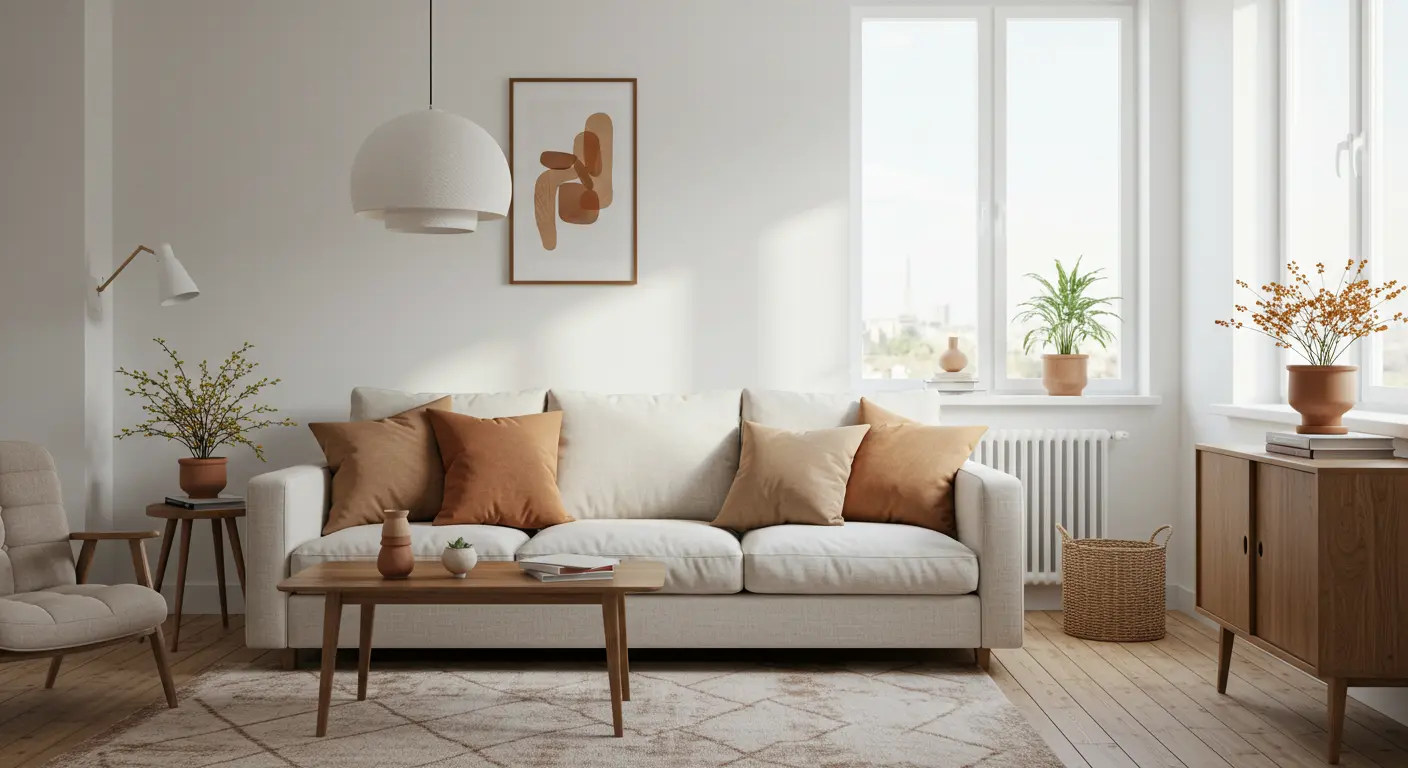
The foundation of minimalism lies in a soft and neutral color palette, which helps convey tranquility, increase the perception of space, and facilitate combinations.
Recommended tones:
- White and off-white: brighten the environment and reflect natural light.
- Beige and sand: warm the space without visually weighing it down.
- Light gray and soft pastel tones: add sophistication with discretion.
These colors also act as neutral backgrounds so that textures and statement objects gain more presence — without visual clutter.
Color accents: balance and personality
Despite the focus on neutral tones, adding punctual touches of color is essential to create an environment with identity.
Suggestions:
- Natural plants like Pothos or ZZ plant, which bring life to the environment.
- Cushions, artwork, and throws in earthy tones, olive green, grayish-blue, or mustard.
- Design objects that add aesthetic value and functionality, such as lamps, vases, or handmade ceramics.
These colorful details help create soft and interesting contrasts, without compromising the clean look.
Natural lighting: your best ally
If there’s a magic trick to visually enlarge a space, it’s natural light. It enhances the elements of the environment, highlights textures, and creates an immediate feeling of freshness and warmth.
Practical tips:
- Use light curtains or linen blinds to allow light entry without compromising privacy.
- Position mirrors opposite windows to reflect clarity and double the sense of space.
- Prefer light walls and reflective surfaces to make the most of daylight.
Well-thought-out artificial lighting
When natural light isn’t sufficient, invest in soft and functional artificial lighting:
- Warm indirect light for bedrooms and living rooms.
- LED spots or track lights to highlight specific areas without exaggeration.
- Simple design lamps that also function as decorative elements.
In minimalism, lighting is considered part of the design — not just a practical necessity, but an aesthetic and emotional element.
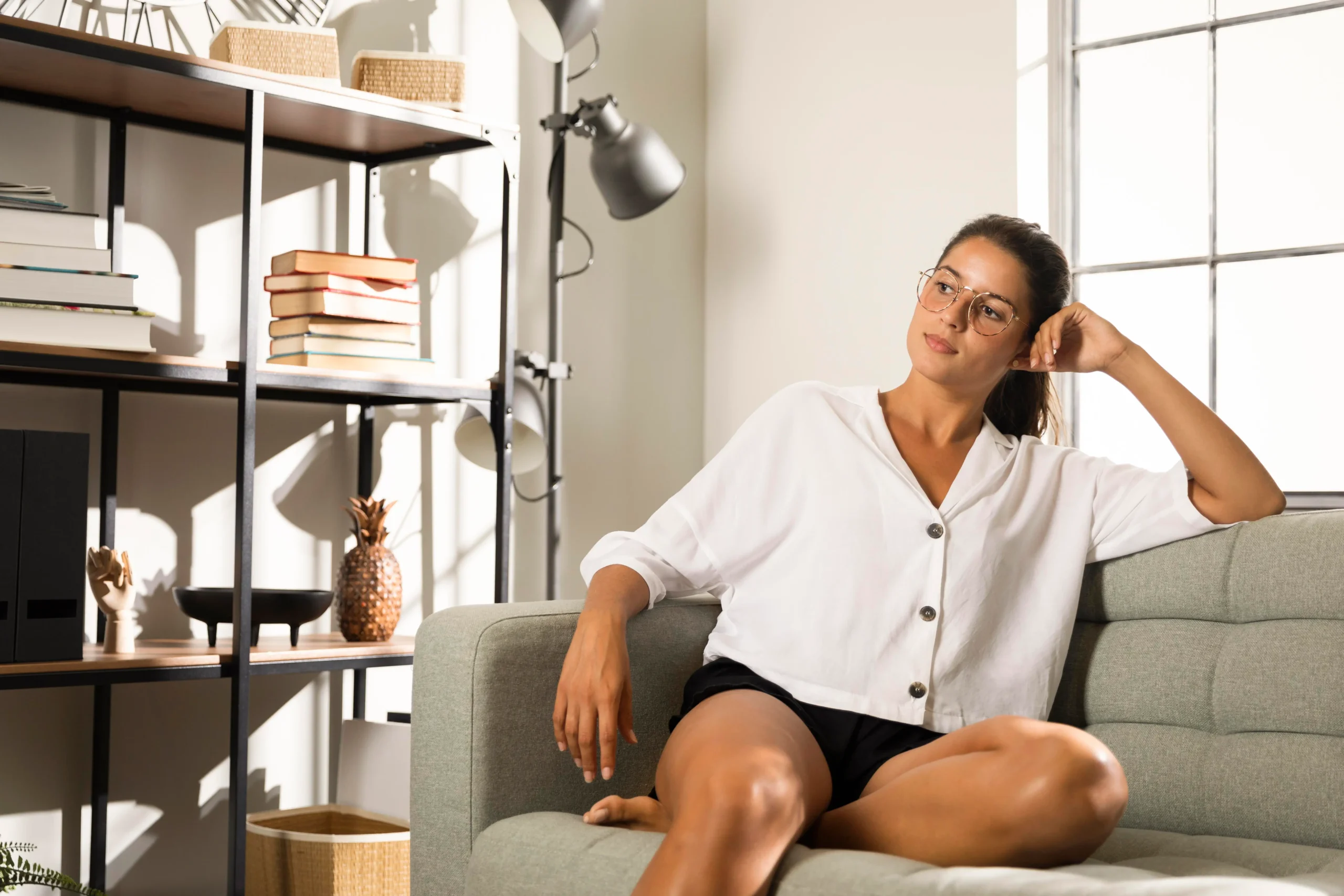
Clean Decor with Personality
Minimalism is not synonymous with monotony. One of the biggest myths about this style is that it requires cold, identity-less environments. In reality, a minimalist home can (and should!) reflect who you are — with elegance, intentionality, and affection in the details.
How to decorate without overwhelming
The key lies in balance: fewer objects, more meaning. Choose few decorative elements, but ensure they have function, history, or aesthetic beauty relevant to you.
Some ideas:
- A minimalist artwork with abstract lines or inspiring quotes
- A handmade sculpture or ceramic piece
- A vase with plants that bring life to the environment
Remember: visually clean spaces enhance the feeling of well-being and favor concentration, rest, and flow in daily life.
Natural textures: sophistication with coziness
One of the best ways to bring warmth and depth to a minimalist space is through textures. They create contrast and visual interest, even when the colors are neutral.
Suggestions:
- Linen, cotton, and wool in cushions, throws, and curtains
- Rustic rugs with natural weave or fibers like jute and sisal
- Raw wood or bamboo in furniture and decorative objects
These elements make the environment more human, sensory, and welcoming — without sacrificing the clean aesthetic.
Focal points that reveal your essence
Even in a minimalist space, it’s important to have one or two focal points that express your personality.
It could be:
- A small art gallery, with uniform frames and images that inspire you
- An art or design book on the coffee table
- A travel souvenir that holds emotional significance
The tip is to choose with intention, not impulse. What’s in your space should represent you — and make you feel at home.
Integrate Minimalism into Your Routine
Minimalism isn’t limited to home aesthetics — it reflects in every daily choice. When you decide to live with less, you’re making space for more: more time, more clarity, more well-being.
Applying minimalism to your routine is a way to maintain home harmony in a lasting and conscious manner.
Minimalism beyond aesthetics: a new mindset
Adopting the minimalist style goes beyond choosing neutral furniture or having fewer decorative objects. It’s about re-evaluating priorities and living with more purpose.
This translates into questions like:
- “Do I really need this?”
- “Does this item or habit contribute to the life I want to lead?”
- “What can I simplify today to have more peace tomorrow?”
This more attentive look at the essential also reflects in home organization, consumption, the time you dedicate to each activity — and even your emotional health.
Create sustainable habits in daily life
Minimalism is also an invitation to conscious consumption and environmental responsibility. Small daily actions can have a big impact, such as:
- Avoiding impulse purchases and prioritizing quality over quantity
- Reusing, recycling, and donating what no longer serves you
- Opting for purposeful brands and durable products
- Reducing the use of packaging and disposable plastics
By simplifying choices, you reduce stress, excess, and even physical and mental clutter.
Living with less to live better
The great transformation happens when you realize that minimalism doesn’t take away — it liberates. It frees up time, space, energy. And this brings real benefits, such as:
- Less clutter and more practicality
- More time for what truly matters
- More mental and emotional clarity
- A calmer and more welcoming environment
Gradually, your minimalist apartment becomes a reflection of your inner life — and the well-being born there spreads throughout all areas of your routine.
Spaces that Inspire Tranquility
The true power of minimalism lies in transforming the home into a space of peace and balance. And this is possible even in the smallest apartments. By applying the concepts of simplicity, functionality, and intentionality, each room can become an invitation to well-being.
Below, you’ll see how to adapt these ideas for the main rooms of your home:
Living room: the heart of the apartment
- Opt for a comfortable sofa proportional to the space
- Avoid excess cushions and decorative objects
- Use a light or multifunctional coffee table
- Enhance natural light with thin curtains and well-positioned mirrors
Bedroom: simplicity for rest
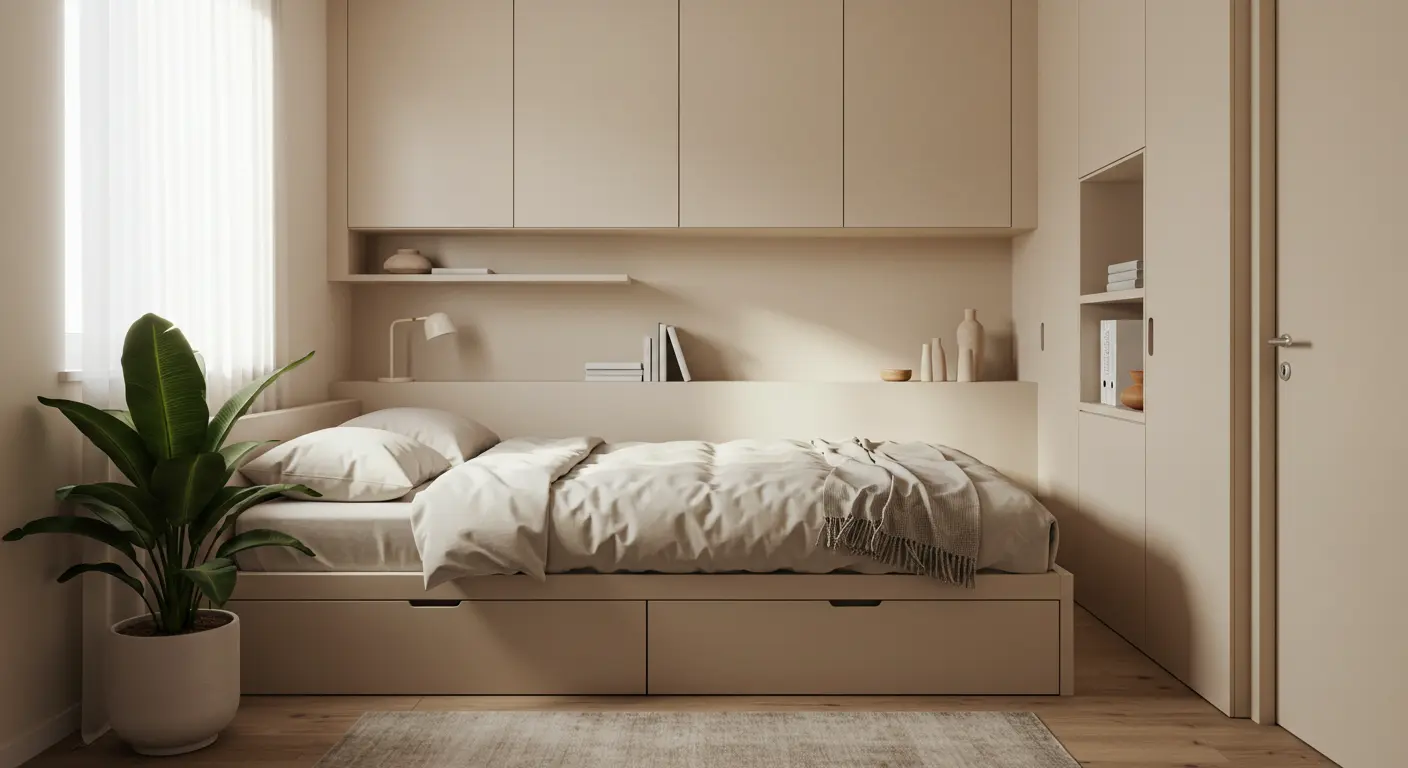
- Choose a bed with a functional structure, like a storage base or built-in drawers
- Create a soft color palette and use natural textures
- Prefer low furniture and built-in wardrobes
- Leave surfaces clear: fewer stimuli, more tranquility
Kitchen: practical and organized
- Use open shelves or niches to keep only the essentials visible
- Opt for few utensils, but of good quality
- Reserve a drawer or box for donations or periodic disposal of useless items
- Integrate the area with the living room, if possible, creating visual spaciousness
Multifunctional corner: work, reading, or hobby
- A compact desk with an ergonomic chair is sufficient
- Use directed lighting and objects that inspire focus and calm
- Store work items at the end of the day to keep the space organized
Table: Functional Layout for Apartments up to 40m² (approx. 430 sq ft)
| Room | Main Function | Suggested Minimalist Solution |
| Living Room | Socializing and relaxing | Small sofa, foldable table, furniture with niches |
| Bedroom | Sleeping and storing clothes | Bed with storage base, built-in wardrobe, simple headboard |
| Kitchen | Preparing meals | Open shelves, essential utensils |
| Workspace | Studying/working with focus | Compact desk, light chair, good lighting |

Conclusion: Your Minimalist Retreat Starts Now
Creating a minimalist environment in your small apartment isn’t about living with less out of obligation, but rather with more intention. Every choice you make — from furniture to the color palette — can transform your space into a true sanctuary of tranquility, functionality, and style.
By applying the tips in this article, you’ll realize that minimalism doesn’t require major renovations or excessive spending. It starts with an attentive eye, conscious choices, and the desire to create a home that truly reflects who you are and how you want to live.
Ready to start this transformation? Embrace simplicity, value functionality, and allow your small apartment to become the minimalist refuge you’ve always dreamed of.
